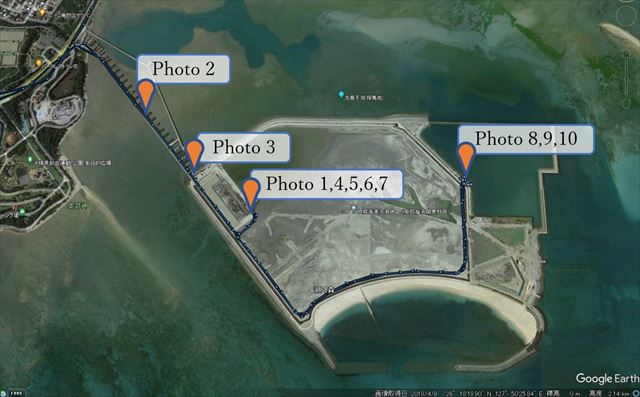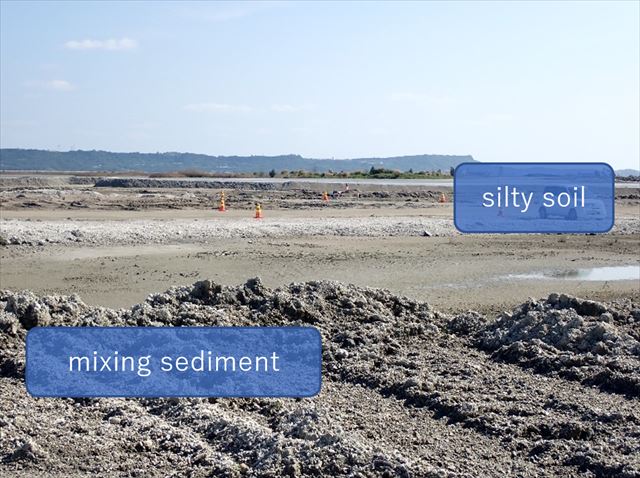Reclamation site in Nakagusuku bay port Awase area.
1/19 2023
Land reclamation is underway as development project of Awase area in Nakagusuku port to revitalize the east coast of the central region of the main island of Okinawa at Awase , Okinawa City. This time, as part of the curriculum of a lecture on port engineering, our laboratory members decided to conduct the landfill construction site visit. The following figure shows the route Map.

Photo 1 Arriving at the landf reclamation site and listening to an explanation.

Route Map
We took a buss to the Artificial island landfill site through on the bridge. We could see “Awase tidal flat” that is one of the largest tidal flat in Okinawa prefecture and habitat for various living organism. To minimize the impact on the surrounding environment, such as Awase tidal flat, a reclamation method of artificial islands was adopted.

Photo 2 Awase tide flat seen from the car window
Near the entrance to the artificial island from the bridge, gravel bags, which is also the subject of this laboratory's research, were seen.

Photo 3 Gravel bags.
At the first site, we observed the mixing and stirring of pumice stone and dredged sediment. Photo 4 shows a pumice stone taken during our laboratory's pumice stone survey of the Motobu Peninsula in October 2021. Photo 5 shows mixed sediment that was mixed with dredged material for reclamation. The mixed sediment was so fine that it was difficult to determine visually whether pumice had been mixed in, but when touched, the slightly light weight and dry texture confirmed that pumice had been mixed in. Since the pumice stone by itself is not strong enough, it is mixed with dredged soil to meet the required strength before being disposed of as land reclamation.

Photo 4 Pumice stone washed ashore on Motobu Peninsula.

Photo 5 Agitated dredged sediment and pumice mixed sediment.
Photo 6 shows the pumice stone mixing operation using the stabilizer. The height of the fill is 60 cm. 30 cm above the ground is dredged material and 30 cm above that is pumice stone, and the stabilizer is mixing the sand at a volume ratio of 1:1.

Photo 6 Mixing of pumice and sediment with stabilizer.
The soil mixture mixed by the stabilizer is spread on top of the silty soil at the land reclamation site (see the back side of Photo 7). The silty soil is too weak to be worked with heavy machinery. By placing the pumice stone mixture on top of the silt, heavy machinery can be used and the pumice stone can be disposed of at the same time.

Photo 7 Silty soil (back photo) and mixed sediment (front photo).
The second site was moved to the east side of the artificial island to observe the operation of pumping dredged material. The dredged material is transported from the dredger to the reclamation site through the pipe that stretches toward the right side of the photo 8.

Photo 8 Pumping barges that pump sediment together with seawater.

Photo 9 Listening to the explanation.
Dredged material is transported by pumping with seawater. Photo 10 shows the discharge of seawater used for pumping sediment. The scene of the drainage was very impressive.

Photo 10 Drainage of seawater for sediment pumping
This time, we were able to have a valuable experience of visiting a reclamation site of an artificial island. Until this site visit, I had thought that land reclamation work was done by transporting sand and soil by vessel to the sea, and then just filling the sea with the sand. However, in the actual site, sediment is transported by water pressure, and we learned some interesting facts. In addition, I realized that the construction of civil engineering structures has various effects and roles even before the structures themselves are completed by observing a site where pumice stone disposal and landfill are underway at the same time.
